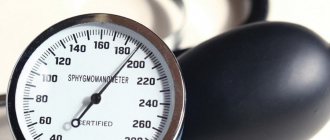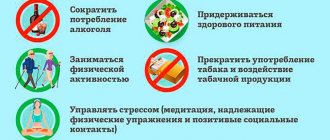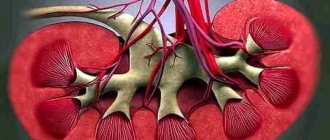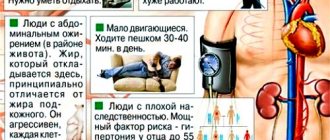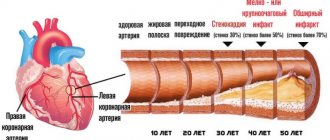A blood pressure of 120 over 100 is not a reason to go to the hospital or call an ambulance. An upper pressure of 120-129 is normal, but a healthy person’s lower pressure should be between 80-91. Heart pressure is an indicator of the work of muscles and blood vessels. The upper reading of the tonometer indicates the force of blood pushing out in large arteries.
In this case, this is the norm and there is no need to worry about your heart. What does lower pressure mean? It indicates the resistance of the vessel walls to blood flow. This means increased stress on the heart muscle. What to do in such a situation? Do not panic, but understand the causes of the phenomenon. Each person has their own norms and deviations.
Causes of pressure 120 to 100
Systolic pressure is within 120-130 mm. rt. Art. is an ideal tonometer indicator, but diastolic pressure above 98 indicates hypertension. But there are cases when the pressure is 125 over 95 or 120 over 100 - this is observed during physical activity or stress. There is no need to try to reduce it, just stabilize the body, and the indicators will return to the usual numbers on their own.
With a “normal” increase in blood pressure, the pulse quickens. A frequency of beats per minute in the range of 80-100 indicates the body’s natural reaction to a stress factor. At rest the pulse is 60-80.
In the morning, blood pressure rises if a person did not sleep properly or ate too much in the evening. Therefore, do not be alarmed by the tonometer reading of 127 to 90, but simply drink green tea and wait an hour. Natural causes of increased diastolic pressure lie in a person’s lifestyle. Lower blood pressure that is higher than normal occurs from smoking, excessive caffeine consumption, and taking medications.
But there are also reasons for high blood pressure that require medical attention:
- Pathology of the thyroid gland.
- Kidney diseases.
- Abnormal functioning of the adrenal glands.
- Vegetative-vascular dystonia.
- Obesity.
If you lead a healthy lifestyle and your diastolic pressure is regularly 101-109, then this is a reason to contact a cardiologist.
Low pulse blood pressure
Many people do not know that there are only three blood pressure values. In addition to systolic and diastolic, pulse pressure indicators are also distinguished.
Pulse pressure depends on the lower and upper pressure. It is calculated by subtracting the diastole value from the systole value. Thus, PP at a blood pressure of 120/100 will be equal to 20. The ideal pulse pressure in a healthy person is calculated according to the scheme 120-80 = 40. However, PP 35 and PP 45 are also not considered a deviation. Ideally, the working pulse pressure should not change during the day . Even during physical activity and stress, the values of the upper and lower pressure should change evenly.
Pulse pressure is considered high if it exceeds 50. With such a range in blood pressure readings, a person will experience quite pronounced discomfort.
Low pressure is called PD, the indicators of which will be less than 25% of the upper pressure. This condition is also accompanied by unpleasant symptoms.
At a pressure of 120 over 100, the pulse pressure will be 20. This figure is less than 25% of the systolic pressure and is half the ideal values.
PD 20 indicates that the heart cannot relax fully while giving blood. The prolonged presence of this condition can lead to wear and tear of the “pump” of our body and blood vessels. For example, low pulse pressure often causes the development of atherosclerosis and tachycardia.
It is worth mentioning the fact that the most dangerous thing is the prolonged presence of low or high pulse pressure. If this phenomenon is short-term, it usually does not lead to any irreversible changes.
Why is blood pressure 120/100 dangerous?
If a blood pressure of 120 over 100 is a sign of hypertension, and a person maintains these values regularly, then this negatively affects the entire body. Upper blood pressure may be normal or even lower, but if the diastolic pressure is above 102, the doctor diagnoses hypertension. This condition is fraught with consequences:
- There is a disruption in blood circulation.
- The load on the heart and valves increases sharply.
- Small vessels receive less blood, which reduces the oxygen supply to adjacent tissues.
- The vascular system suffers - atherosclerosis, cholesterol plaques, ruptures, thrombosis - this is fraught with pressure of 120 to 100 on an ongoing basis.
The most dangerous is advanced hypertension. For a long time, a person does not feel any disruptions in the functioning of the heart or problems with blood circulation, but the accumulated substances in the vessels will then make themselves known sharply. Do not try to figure out on your own what such a jump and constantly high lower pressure means, but seek help from a specialist.
What pressure is considered normal?
A person’s blood pressure has two indicators - the upper (systolic), recorded at the moment the heart contracts, and the lower (diastolic), noted when the heart relaxes and pushes blood into the arteries. When the heart and capillaries are functioning normally, the tonometer readings are within 120/80 or 110/70; a slight deviation up or down is not considered a pathology.
For each person, the pressure is individual, but, in addition to fixing the two indicators, it is necessary to monitor the difference between them. This difference is called pulse pressure and can also indicate existing health problems. Changes in tonometer readings are affected by:
- Times of Day;
- nervous tension, stress;
- physical exercise;
- binge eating;
- alcohol consumption;
- taking certain medications.
If, after an unexpected increase in blood pressure (BP) levels, the indicators stabilize on their own, and the fact of jumps is rarely observed, there is nothing to worry about. The normal difference between the upper and lower limits should be from 35 to 55 mmHg, and a regular decrease in this indicator indicates the development of cardiovascular pathology.
Symptoms of pressure 120 to 100
123 over 92 is not an indicator of hypertension if a person does not have other abnormalities and side signs of high blood pressure every day. But 128 to 102 is already a pathological condition. Hypertension has its own accompanying symptoms that will help determine the disease and its causes:
- Headache.
- Dizziness appears.
- Nausea, rarely - vomiting occurs, it does not bring relief.
- The pulse quickens.
- Shortness of breath appears in a calm state.
- The clarity of vision is impaired, the eyes become cloudy.
- There is blood coming from the nose.
- A sharp change in sensations between heat and cold.
All these signs are useful for diagnosing hypertension when the systolic pressure is normal and the lower pressure is above 96-103. Pressure 120 over 100 - only a doctor will tell you what this means, having assessed the existing symptoms and your condition. He will make a diagnosis and prescribe treatment if necessary.
You shouldn’t take measures to suddenly lower your blood pressure on your own. Your upper blood pressure may also drop, and then you will only feel worse.
Why is the heart rate high?
An increased pulse is considered to be an attribute of arterial hypertension, but even with a pressure of 120 per 100, a pulse of 100 or even 120 beats per minute is not uncommon, but rather the rule. Increased heart rate is explained by the heart's attempt to compensate for insufficient cardiac output.
If a compensatory response in the form of an accelerated heartbeat is observed at a pressure of 120 over 100 (pulse 120), it means that the body is trying to prevent a vascular or cerebral catastrophe. But despite the efforts of the cardiovascular system to restore normal blood circulation by increasing the heart rate, this condition cannot be called harmless.
Blood pressure 120/100 during pregnancy
For a woman in a position, pressure fluctuations are a common thing; it all depends on the timing and condition of the fetus. The body adapts to the new role and the tonometer readings are unstable. During pregnancy, blood pressure of 120 over 100 is normal for short-term rises and lasts for no more than 4-5 hours in a row. But if the lower reading is above 104, and the pregnant woman experiences discomfort or heart problems, then this is a reason to consult a doctor. Blood pressure is 120 over 100, what it is and why it does not fall during pregnancy can only be said after an examination.
If measures to reduce diastolic pressure are not taken in a timely manner, the risk for the expectant mother and fetus increases, the heart suffers greatly and the abdominal organs come under attack.
Reasons for a sustained increase in diastole
What does pressure 120/100 mean if the lower reading is constantly elevated? Doctors warn about the danger of developing isolated diastolic hypertension when only the lower reading fluctuates. A similar diagnosis is made if the tonometer readings are constantly recorded: the upper one is below 140, and the lower one is above 90.
Previously, doctors believed that it was important to control only systolic pressure, and diastolic pressure was not so important, but later the importance of both marks was confirmed. Isolated diastolic hypertension often goes unnoticed, because a person does not feel the severe symptoms inherent in the disease. It is sometimes possible to detect jumps in the lower numbers only during routine examinations by a cardiologist.
A steady increase in the lower pressure threshold is noted for a number of reasons:
- kidney disease (most often chronic glomerulonephritis) - in this case, the vessels in the renal system undergo destructive changes. The veins and arteries located there narrow, causing an increase in lower pressure;
- malignant and benign neoplasms in the kidneys - they provoke a constant release of adrenaline into the blood plasma, which is why the diastolic indicator is always elevated;
- problems with the endocrine system - observed in women during menopause, pregnancy, as well as in patients with thyroid pathologies (hypothyroidism, hyperthyroidism, diffuse goiter);
- Essential hypertension is a condition in which an increase in diastolic pressure is provoked not by existing diseases, but by a general poor emotional or physical state of the body. Often, doctors cannot determine the true cause of blood pressure surges until they conduct a full examination of the body.
Why might a person still exhibit signs of isolated diastolic hypertension? Unfavorable factors affecting the condition of the heart and blood vessels include excess weight, poor diet, lack of a good night's rest, psycho-emotional and physical stress.
Unfortunately, if a person’s blood pressure becomes normal at 120/100, doctors may suspect the development of atherosclerosis.
Treatment methods and diagnosis
If you are not satisfied with a blood pressure of 120 over 100, this is much higher than your norm, and such indicators persist for a long time, then consult a doctor. At home, you can only temporarily lower your blood pressure, but without eliminating the cause of its increase, you will not get rid of the problem. Diagnosis comes down to identifying the factor that caused the tonometer readings to change above normal. Tests and examinations are prescribed.
But in order to quickly eliminate the problem, until a treatment regimen is prescribed and the doctor tells you which tablets or drops to take, you need to adhere to the following rules:
- Avoid excess weight; if you are obese, switch to a diet.
- Do not eat foods high in caffeine.
- Set a daily routine.
- Get enough sleep.
- Avoid stressful situations.
- Stop using nicotine and alcohol.
- Switch from a sedentary lifestyle to an active, mobile one.
This way you will improve the functioning of the body, help the heart and blood vessels cope with the load until you finally eliminate the cause of hypertension.
What to take - names of medications
In men and women, an increase in lower pressure can significantly affect well-being. Therefore, there are medications that lower diastolic pressure:
- Verapamil or Nifedipine are calcium antagonists that can dilate the walls of blood vessels.
- Metoprolol or Terazonite belong to the group of beta blockers.
- Captopril or Enalopril - produce angiotensive hormones. Act as ACE inhibitors.
- Xipamide or Hypothiazide - accelerate fluid excretion and reduce the number of heart contractions.
The names of many drugs are unfamiliar to people, and their action and influence on the body is even more so. Therefore, before taking medications, consult your doctor.
Diuretics have the fewest contraindications and a quick effect; other drugs can be taken only on the recommendation of a specialist.
Causes
As a rule, a change in lower (diastolic) blood pressure with normal upper (systolic) blood pressure indicates an increase in the tone of the blood vessels, resulting in strong resistance to blood flow.
Even an insignificant difference leads to additional stress on the myocardium. And, as you know, it has the most undesirable effect on the functionality of all internal organs.
Factors influencing an increase in lower pressure may be the following:
- serious diseases of the excretory system;
- dysfunction of the thyroid gland;
- problems with the adrenal glands;
- the occurrence of vegetative-vascular dystonia;
- the presence of harmful habits, which include smoking and alcohol abuse;
- negative impact of environmental factors;
- presence of extra pounds;
- improper and unbalanced diet;
- passive lifestyle;
- constant emotional experiences that have a detrimental effect on the nervous system;
- long-term use of certain medications;
- overeating, especially before bed.
All of the above factors affect the lives and health of millions of people around the world. The percentage of those people who do not experience any problems with this lifestyle is small.
First aid at home
To get rid of the unpleasant symptoms of hypertension or pressure surge at home, you can take:
- One tablet of Capoten. Place it under your tongue and suck it slowly. Effect within 30-60 minutes.
- Corvalol – 40 drops diluted in a glass of water. The tonometer readings decrease within half an hour. Corvalol tablets are used only for long-term therapy.
- Valerian tincture. Use as directed or make your own. Pour a tablespoon of grated valerian root with a glass of boiling water and leave overnight. Strain, drink 1 tablespoon before meals.
- Motherwort. For 2 tbsp. motherwort requires 2 cups of boiling water. Pour in the grass and let sit for 15 minutes. You need to drink it three times a day before meals and at night.
These drugs and methods will help to immediately lower your blood pressure if it has not risen above 120 to 100. In other cases, first aid at home will not bring results and you will need to take medications, consult a doctor, or call an ambulance.
If there is a sudden increase in pressure, provide fresh air, unbutton your collar, apply a damp, cold towel to your neck, and take a comfortable sitting position.
Preventive and therapeutic measures to restore arterial levels
What to do if the pressure is 120 over 100? In medicine, it is generally accepted that hypotension does not require intensive and complex therapy, since such a blood pressure value does not pose a significant danger to the body. At the same time, less therapeutic efforts are required to stabilize it.
As a rule, to regulate it, doctors recommend:
- Increase physical activity.
- Proper rest.
- Positive psychological climate.
- Taking medications.
- Use of aids.
| Treatment methods for hypotension | Peculiarities |
| Increased physical activity | With hypotensive blood pressure, it is necessary to gradually increase physical activity to help improve the condition of the heart: running, volleyball, walking, tennis, swimming, morning exercises (at least 30 minutes a day). |
| Proper rest | Be sure to maintain an active and nightly sleep schedule. For patients with hypotension, the duration of night sleep should be at least 10-12 hours, while for ordinary people, 8-9 hours is enough for proper rest. In case of hypotension, doctors recommend avoiding daytime sleep, even in case of severe drowsiness and weather conditions. |
| Healthy psycho-emotional attitude | It is necessary to avoid negative emotions and excessive psycho-emotional stress, which can lead to a significant drop in blood levels. |
Taking medications
The possibility of normalizing blood pressure to 120/100 through the use of medications cannot be ruled out, but they must be used with extreme caution so as not to further harm your body.
Medicines you can take:
| Drug group | List of medications that can lower blood pressure |
| Caffeinated | Citramon. Pentalgin. Mezaton. |
| Adaptogens (tinctures) | Echinacea. Hawthorn. Ginseng. Schisandra. Eleutherococcus. |
| Antispasmodics | No-shpa. Papazol. |
| Alpha and beta blockers | Metoprolol. Therazonin. |
| Diuretics | Hypothiazide. Xipamide. |
| Calcium antagonists | Verapamil. Nifedipine. |
| ACE inhibitors | Enalapril. Captopril. |
You can drink 40 drops of Corvalol per 50 ml of water or Capoten tablet.
Home Remedies
At home, as first aid, the following will help improve your condition: coffee, tea, wine.
Helps relieve nervous tension:
- Motherwort infusion: 2 tbsp. Brew the plants with 2 cups of boiling water, let it brew for 15 minutes and consume 3-4 times a day and before bedtime.
- Valerian infusion: 1 tbsp. crushed valerian root in 1 cup of boiling water, leave overnight, filter and drink 1 tbsp. after meals 3-4 times a day.
Do I need to see a doctor?
If pressure parameters of 120/100 persist for a long time, while the person’s condition worsens, a severe headache begins, nausea, darkening of the eyes and other painful signs appear, it is necessary to visit a cardiologist who will prescribe treatment to regulate blood pressure.
Patients with prolonged blood pressure of 120-129/100, which is accompanied by severe pain, should not be treated independently, since such a decision may cause irreversible consequences. In this case, you need to contact a cardiologist or therapist.
Prevention
To avoid an increase in diastolic pressure and the development of hypertension, adhere to the following rules:
- Increase your level of physical activity if you have a sedentary lifestyle.
- Reduce your salt intake in pure form, as well as in prepared foods (fast food, takeaway, sauces).
- Don't overload your body, give it a rest, walk in the fresh air or do calm, favorite things.
- Reduce your stress levels.
- Cigarettes and booze are your worst enemies, forget about them.
- Give up coffee.
- Distribute your meals, make a meal schedule, and don’t overeat.
- Get rid of excess weight.
The circulatory system will quickly return to normal if you follow these tips. Without pills, you can eliminate hypertension in the initial stages, the main thing is to constantly measure your blood pressure to control it, and lead a healthy lifestyle.


